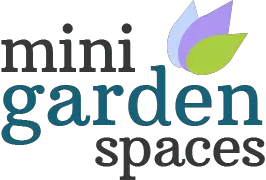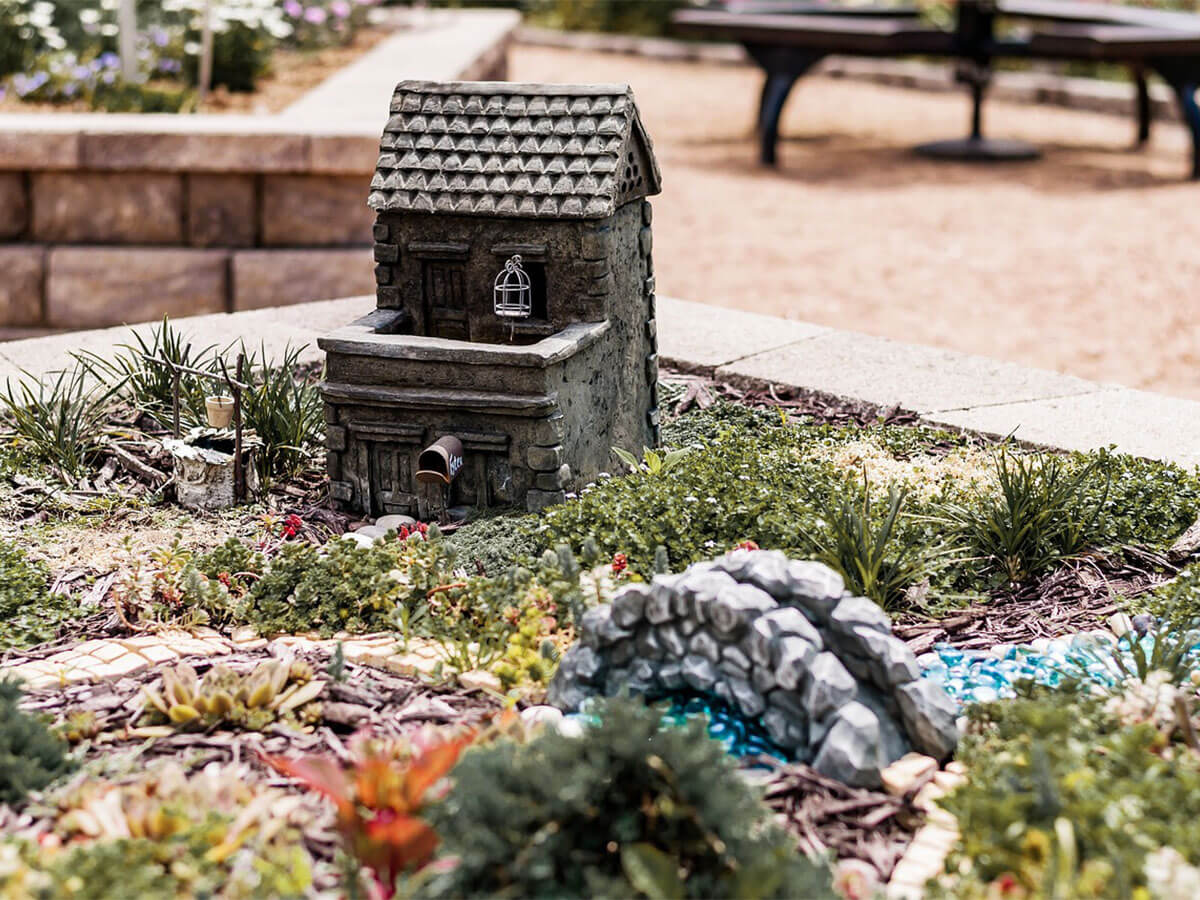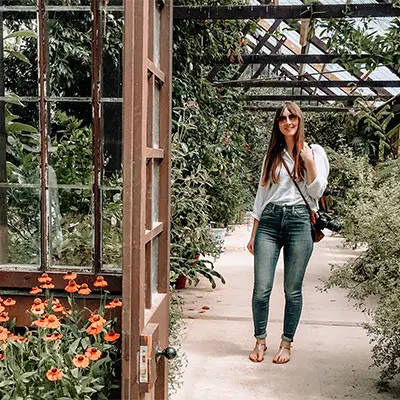How to Create a Mini Fairy Garden
March, 2023 |Looking for a fun summer project? How about creating your own mini fairy garden? Not just for children, creating a mini fairy garden is a great way to let your imagination run wild.
It’s a great way to introduce yourself to gardening and connect with plants and nature. Also, when they’re filled with flowers and plants they simply look fantastic! Almost like a mini zen garden.
How to create a mini fairy garden in 5 easy steps
Find inspiration on how to create your own mini fairy garden with these easy-to-follow steps. With lists of small plants to create the ultimate tiny enchanted landscape, to decoration ideas like tiny stepping stones, seashells, and swing sets!
We’ve also created a guide to make your own mini Jurassic garden which could be great fun for children playing with mini dinosaur toys.
1. Creating a plan and theme
Choosing a theme can help you narrow down what sort of plants or decorations you’d like to include in your fairy garden.
For example in an enchanted rainforest, small tropical-looking plants like coleus would work really well. And in a fairy ‘desert’ landscape, sand, cacti, and mini succulents would look amazing.
A few ideas to help you get creative!
- Enchanted rainforest (mini tropical plants like coleus)
- Magical woodland (tiny ferns and mosses)
- Mythical meadow (cloud grass and tiny flowers)
- Fairy Town, with multiple houses!
- Ethereal rock garden (rocks, mosses, and sedum)
- Fairy desert landscape (use succulents and cacti)
- Mysterious mountainside (great for mini alpine plants)
Although of course, anything goes! Have fun mixing up colors and plant styles to create your own perfect landscape.
Having a few focal points can help you narrow things down. Like a mini fairy house or a certain tiny tree.
Choosing containers:
You can create a mini fairy garden in any part of your garden. Though containers work well as it keeps the mini landscape ‘contained’ to one specific area.
You could use any pots or planters you can find, as long as they have drainage holes. From a wide stone alpine planter to a plastic pot. You could even get creative with a stepped or vertical planter!
I’d recommend for the planting area be at least 1.5ft (45cm) in size, as although we’ll list some tiny plants, they’re not quite lego sized!

Best time to create a mini fairy garden:
Often, the best time to create your fairy garden is Spring. This will give you time to sow any annual flower seeds that you’re growing yourself. Plus, it’s also a time when plant nurseries will be full of new annual plug plants for the season.
Of course, though, you can create a fairy garden at any time of year with indoor plants, or winter-hardy evergreens!
2. Best plants for a mini fairy garden
To create the most authentic look in your mini fairy garden, I’ve put together a list of tiny plants that you could include. They’re a mix of colors, shapes, and textures, but each will help you create that enchanted garden look.
Most of these plants will stay very small. Some will cascade over the edge of your container. Others may eventually need some pruning if your fairy garden is a permanent fixture in your garden.
To help you browse, I’ve divided it into three categories: Ground cover, greenery (trees and shrubs), and flowers!
Best fairy garden plants for ground cover
These plants will cover the bare compost at the top of your planter and recreate the look of grass or flower beds. They’re low-growing and have a natural, creeping habit. So, as they grow, they’ll cover more soil.
Moss: You can find sheets of moss from online sellers. Use it to create a tiny authentic looking forest garden!
Creeping Jenny: A lovely trailing plant with golden foliage that can cover the compost and also cascade over the edge of your planter.
Sedum acre: Often known as gold moss, this plant will create a beautiful mat of golden foliage. It also produces yellow flowers in the summer.
Scleranthus biflorus: A mat-forming evergreen that almost looks like fake model grass!
Dichondra: In silvery blue or emerald green, another trailing plant that will cascade over the edge of your planter. Dichondra ‘Silver Falls’ has beautiful silver-colored foliage that adds an ethereal charm to a mini fairy garden.

Best plants for trees, shrubs, and greenery
These plants are ideal for recreating the look of mini trees and shrubs in your landscape.
Fairy castle cactus: I had to include this one because of the name! A sweet little castle, I mean cactus, that resembles castle turrets and towers.
Coleus: A vibrant foliage plant, perfect for adding color. Some varieties have incredible bright pink foliage.
Sempervivum: Little succulents with a rosette of fleshy leaves. Sempervivum ‘Cobweb’ is one of my favorites! If you’d like to add plants with purple leaves to your fairy garden, then Sempervivum ‘Onyx’ or purple-leaf false shamrock are lovely options!
Dwarf ferns: The Lemon Button Fern or Fluffy Ruffles Fern are both miniature species that stay small and compact.
Cloud grass: Produces dreamy, delicate flower heads that resemble a hazy cloud!
Dwarf conifers: As evergreens, dwarf conifers are perfect for adding year-round foliage to your fairy garden. They’re also very slow-growing, which means they won’t outgrow your pot anytime soon!
You can also find them in a variety of enchanting colors and shapes. Like the spiraled needles of Cryptomeria japonica ‘Spiralis’!

Best flowers for fairy gardens
These mini flowers will bring color and a little height to your tiny fairy garden. They’ll add jewel-like color and a really enchanting look.
Some are naturally tiny, others are mini cultivars of some classic garden flowers.
Lobelia: Creates a haze of tiny flowers and foliage that may cascade over the side of your planter. Available in shades of blue, purple, pink, and white.
Oxalis alpine: Unique, clover-like foliage with pretty pink flowers.

Creeping Thyme (Thymus serpyllum): A mat-forming evergreen, perennial that produces beautiful purple flowers in summer.
Dwarfing Candytuft: Sweet little clusters of low-growing annual flowers in candy colors.
False Babystars (Leptosiphon androsaceus): Tiny pink, white, and yellow flowers.
Sweet Alyssum: Carpets of tiny clusters of pink, purple, or white flowers.
Dwarf Johnny Jump Ups (Viola x williamsiana ‘Sweeties’): Produces mounds of tiny flowers in sweet shades.
I’ve put together a bigger list of dwarfing annual flowers if you’d like to browse more!

3. Adding soil and compost
If you’ve chosen a certain group of plants, like succulents or alpines, choosing the right soil can help your fairy plants thrive.
For example, if you’re only using alpine plants, a bag of alpine soil mix is ideal! However, if you have a mix of plants, or already have some compost to hand, any bag of compost will work.
To help with drainage, it might be useful to place some small rocks at the bottom of your chosen container to stop the soil from becoming too waterlogged.
Fill your container half full with compost. This leaves you space to practice positioning your fairy plants so you can create your desired arrangement.
4. Assembling your mini fairy garden landscape
It’s time to get planting! Make sure you leave a little bit of space in-between plants as they will get a bit bigger (depending on the time of year).
Take plants out of their pots and place them inside the container. Once you’ve finished arranging your plants, you can then carefully fill in the gaps with compost.
To bring the scene to life, here are some examples of extra natural materials you can add. These can help you create the ultimate enchanted fairy garden look.

Wood chips or pine needles
Bark mulch or wood chips can help to recreate a woodland pathway. It also works really well as a mulch to help keep moisture locked in so you need to water the garden less often.
Moss
Find sheets of moss online to help you create a real enchanted forest garden look.
Twigs and logs
You might choose to create a tiny swing set out of twigs or create a mini campfire. Or perhaps an upturned log could be the place where you attach a little fairy door.
Pebbles, rocks, and sand
Tiny pebbles can make an excellent pathway. Flat stones like slate can also make authentic-looking tiny stepping stones. Sand is also perfect for creating a desert or beach-inspired look.

5. Adding fairies, accessories, and decorations
From mini toadstools to fairy figures and doorways. There’s an amazing variety of tiny fairy-style decorations that can help to put the finishing touches on your mini fairy garden.
Here’s a list of decorating ideas…
Seashells
If you have any old seashells hanging around from beach walks or holidays they can make a cute addition to a mini fairy garden. Use tiny shells to line a little pathway or attach them to the outside of a fairy house as decoration.
Crystals, marbles, beads, and semi-precious stones
You could add a magical flair to your fairy garden with crystals or semi-precious stones. Blue beads or marbles can make excellent water features, for example, rivers, ponds, or streams.

A tiny pond
You could try sinking a tiny bowl into your pot to create a mini pond. Or a hot tub! Whatever your fairies fancy.
Mini solar lights
Fairies might need a little light too! Mini solar lights are a great way to let you enjoy your mini fairy garden, even at night.
DIY fairy door or gate
A fairy garden would be incomplete without a little doorway! You can easily make your own fairy door at home using popsicle sticks, paint, and wood glue. Attach it to a log to recreate a mini fairy house.
Old doll house figures and furniture
Wooden furniture from an old doll house can add a realistic charm. From tiny bathtubs to chairs and benches. As long as you don’t mind using them outside! You can often find items on eBay or Etsy.
Tiny vegetable garden
A fun idea could be to create a mini vegetable patch! You can often find little wooden carrots or vegetable shapes in craft shops.
Signs and house names
If you decide to name your fairy garden, you could create a tiny wooden sign from popsicle sticks or a piece of bark. Paint or carefully write the name on it and stick it above the door.

Perfect for small gardens
Mini fairy gardens are a great child-friendly idea for small garden spaces. They can give children endless hours of fun as they play with fairy figures or other toys along the little pathways and amongst the tiny conifers. It’s a great way to keep young minds occupied when they might not be able to run around a garden.
When garden space is limited, creating a mini landscape like a fairy garden is a great way to bring different styles into your garden. You can have a mini container rock garden in one, and an enchanted fairy woodland in another.
Creating a mini fairy garden is great fun. No matter what materials or decorations you have on hand (and really, no matter your age!). It’s easy to create your own tiny, enchanted world.








